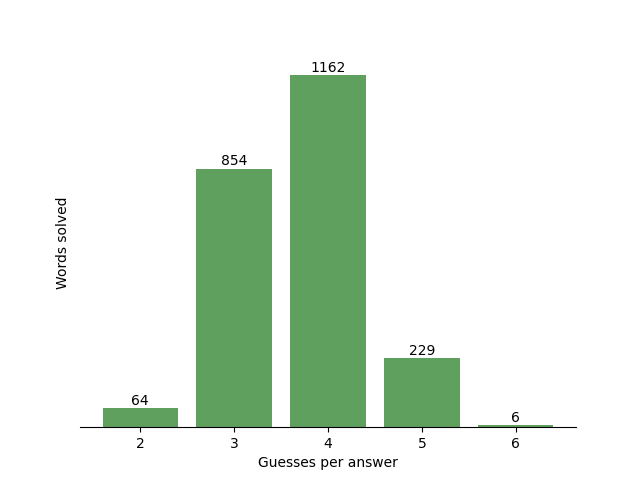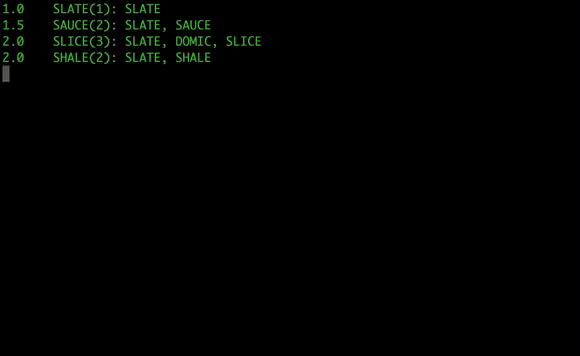This is a python tool to solve Wordle.
Wordle is a five letter English word guessing game where the player must guess a target word in six guesses. For each attempt, the player enters a five letter word and receives feedback for each letter:
- Correct letters not in their correct positions will be marked yellow.
- Correct letters in their correct positions will be marked green.
- Letters that are not included in the target word will be marked gray.
The goals of this project are:
- To solve all 2315 answer words in 6 guesses or fewer without backtracking. Currently all words are solved in 6 words or fewer with 89.8% solved in 4 and under. Using the starting word
SALET, only 6 words require 6 guesses, but the overall average is 3.6799. UsingSLATEas the starting word, there are 12 words that require 6 guesses but the overall average drops to 3.676. - To achieve the lowest possible guess average which is currently 3.676 guesses per puzzle, starting with
SLATE. - To implement an algorithm that is not dependent on a given wordset. While this repository is tested on a static wordset, the algorithm should perform equally well if new words are added or removed. This is different than a shortest path based solution like this other one I wrote, which runs through a tree of decisions from the root word to every leaf and then selects the shortest path.
- To provide an interactive command line tool that helps select the next best guess based on whatever previous guesses have been submitted.
There are two dictionaries used by the game:
- nyt-answers.txt includes 2315 words which are valid puzzle answers.
- nyt-guesses.txt includes 10637 words which can only be used as guesses but will not be solutions to daily puzzles.
The answers list is initially sorted by the popularity of letters in their respective positions. This is important for getting words with the highest word score.
At the start and after each guess, the algorithm finds the next best guess using the following steps:
- After each guess, the guessed word will be compared against the target word, tallying the green, yellow and gray letters. This will be used to prune the remaining answers. See here
- If the count of remaining answers after pruning from game feedback is above 50, then it simply returns the highest scoring answer from the remaining answers. If the count of available answers is below 50, then an intersecting guess is made. This is a guess that attempts to partition the remaining answers in the greatest way possible. See here
- As soon as the answers are pruned down to 2 or fewer, it will pick the first answer (which will always have the highest word score) and then finally the last remaining answer if necessary.
After each guess, the answer list is pruned so that:
- Words without green letters in the right position are removed
- Words without yellow letters are removed
- Words with gray letters are removed
NOTE: Initial implementations missed one important improvement: Yellow letters are not letters in any position, they are letters in only 4 possible positions. Therefore the second bullet above was updated to:
- Words (without yellow letters) OR (with yellow letters in the same position they have already been tried) are removed.
Once the answers are pruned to fewer than 50 words, but greater than 2 (usually after one or two guesses), the algorithm will try to make a blended match I call an intersecting guess. These guesses are not attempts to identify the word directly, but to partition the remaining words maximally. To do this, it will look at the set of distinct letters in the answer list and subtract the set of letters that have already been matched in guesses. From this target set, it will find a word (using a combination of guesses and answers) with letters that can reduce the available answers the most. Note that it may select a word with previously used letters in order to capture the highest number of target letters. This helps prune answers when they have many common letters. For more info see the function _find_best_intersecting_word() in wordle_solver.py.
Let's look at the target word HOUND. The algorithm will start by guessing SLATE and then CRONY which will yield a green match on N in the 4th position and a yellow match on O. Once we filter out all the words that:
- Don't have an
Oor have anOin the third position. - Don't have an
Nin the 4th position. - Have any of the gray letters:
{S,L,A,T,E,C,R,Y}.
This will only leave 9 words in the answer list: {BOUND, POUND, FOUND, DOING, MOUND, GOING, WOUND, HOUND, OWING}.
As you can see, most of these words have 4 of the same letters and most are in the same position, so if we were to continue with the algorithm as is, it would take 8 guesses to solve HOUND. That's why it makes more sense here to take the letters {M, H, D, U, G, F, W, Z, J, Q} (letters that are in the answer list but have not been matched as green or yellow yet) and find a word with as many of those letters as possible. In this case, the word HUMID does well, and after that the answer list is down to just one word: HOUND. With this improvement it only takes 4 guesses to solve it: SLATE>CRONY>HUMID>HOUND
It's worth mentioning that this improvement brings down many words that take more than 4 guesses to solve, particularly 20 words that could not be solved at all in 6 guesses. However there are many words for which it degrades performance by adding an extra step, when an otherwise lucky guess would do better. This is an acceptable compromise for our main goal which is to bring down the upper end of the distribution.
Take LABEL as an example. After a starting guess of SLATE, the remaining answers will be pruned to only 31. The highest scoring of these (based on letter frequency) is BALER, which after guessing would only leave 1 word: LABEL. Using the intersecting guess after SLATE, the guesses will be: GRIND and CHUMP before landing on LABEL. So, the intersecting guesses increase the number of steps from 3 to 4.
Please check out this other project, written in Rust, that determines the lower bound for all answer words using a binary heap to explore all possible paths, finding the guaranteed minimum.
The current version can be used in 2 different ways:
First, by running SolverTest.py with no arguments it will parse the entire answer list and solve them, printing out a running average, the word it solved, the number of guesses and the word path for each answer.
Example:
$ ./wordle_runner.py
For debugging purposes, you can enable logging with export WORDLE_LOGGING=1; ./SolverTest.py.
You can test a single word with the -w WORD option:
$ ./wordle_runner.py -w alert
Solved: ALERT in 4 guesses:
SLATE, CRAPE, ALTER, ALERT
You can find the rank of a word in the overall word scores with the -r WORD option:
$ ./wordle_runner.py -r alert
8/12953
And finally, you can get the individual score of a word with the -s WORD option:
$ ./wordle_runner.py -s alert
4554
This is the most useful thing you might want to use while you are actually solving the puzzle online. It will recommend the player's next guess, receive the player's chosen guess along with green and yellow letters:
$ ./wordle_interactive.py -s
Example:
$ ./wordle_interactive.py -s
What is your first word guess? (press ENTER for SLATE)
> slate
You entered: SLATE
Please enter green letters (press ENTER for none)
> t
Please enter yellow letters (press ENTER for none)
> a
15 possible answers
Your next guess should be: PRICY
What is your next guess? (press ENTER for PRICY)
> pricy
You entered: PRICY
Please enter green letters (press ENTER for none)
> py
Please enter yellow letters (press ENTER for none)
>
1 possible answers
Your next guess should be: PATTY
What is your next guess? (press ENTER for PATTY)
> patty
You won 😉 in 3 guesses!
Use without the -s option to omit suggestions for subsequent guess.
- S is the most frequent starting letter.
- A is the most frequent second and third letter.
- E is the most frequent fourth and fifth letter.
Below is a table of calculated frequencies in all positions.
| Position | Letter:Frequency in Answers |
|---|---|
| 1 | S:366, C:198, B:173, T:149, P:142, A:141, F:136, G:115, D:111, M:107, R:105, L:88, W:83, E:72, H:69, V:43, O:41, N:37, I:34, U:33, Q:23, K:20, J:20, Y:6, Z:3, X:0 |
| 2 | A:304, O:279, R:267, E:242, I:202, L:201, U:186, H:144, N:87, T:77, P:61, W:44, C:40, M:38, Y:23, D:20, B:16, S:16, V:15, X:14, G:12, K:10, F:8, Q:5, Z:2, J:2 |
| 3 | A:307, I:266, O:244, E:177, U:165, R:163, N:139, L:112, T:111, S:80, D:75, G:67, M:61, P:58, B:57, C:56, V:49, Y:29, W:26, F:25, K:12, X:12, Z:11, H:9, J:3, Q:1 |
| 4 | E:318, N:182, S:171, A:163, L:162, I:158, C:152, R:152, T:139, O:132, U:82, G:76, D:69, M:68, K:55, P:50, V:46, F:35, H:28, W:25, B:24, Z:20, Y:3, X:3, J:2, Q:0 |
| 5 | E:424, Y:364, T:253, R:212, L:156, H:139, N:130, D:118, K:113, A:64, O:58, P:56, M:42, G:41, S:36, C:31, F:26, W:17, B:11, I:11, X:8, Z:4, U:1, V:0, J:0, Q:0 |
With these frequencies, we can calculate a score for each word based on the letters it has in positions 1 through 5. The 50 highest scoring answer words are, in order:
1-10: SLATE, SAUCE, SLICE, SHALE, SAUTE, SHARE, SHINE, SUITE, CRANE, SAINT
11-20: SOAPY, SHONE, SHIRE, SAUCY, SLAVE, SANER, SNARE, STALE, CRATE, SHORE
21-30: SUAVE, SLIDE, STARE, SLIME, BRACE, SHINY, CRONE, BRINE, SHADE, SPACE
31-40: SPARE, SHAME, SLANT, SCALE, SPINE, TRACE, SHAKE, STONE, SHAPE, SCARE
41-50: SHAVE, SALTY, SLOPE, SINCE, POISE, SWINE, BONEY, SNORE, STOLE, SADLY
If you use this or would like to contribute, feel free to fork, contact me or submit a PR.


